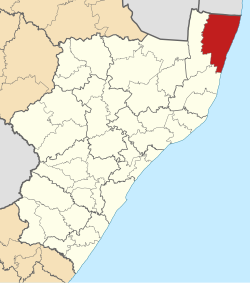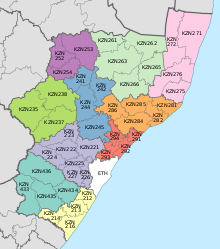uMhlabuyalingana Local Municipality
uMhlabuyalingana | |
|---|---|
 Location of UMhlabuyalingana Local Municipality within KwaZulu-Natal | |
| Coordinates: 27°1′S 32°44′E / 27.017°S 32.733°E | |
| Country | South Africa |
| Province | KwaZulu-Natal |
| District | uMkhanyakude |
| Seat | Kwangwanase |
| Wards | 17 |
| Government | |
| • Type | Municipal council |
| • Mayor | D. A. Ncube |
| Area | |
| • Total | 3,964 km2 (1,531 sq mi) |
| Population (2011)[2] | |
| • Total | 156,736 |
| • Density | 40/km2 (100/sq mi) |
| Racial makeup (2011) | |
| • Black African | 99.3% |
| • Coloured | 0.1% |
| • Indian/Asian | 0.1% |
| • White | 0.3% |
| First languages (2011) | |
| • Zulu | 95.7% |
| • English | 1.2% |
| • Southern Ndebele | 1.0% |
| • Other | 2.1% |
| Time zone | UTC+2 (SAST) |
| Municipal code | KZN271 |
uMhlabuyalingana Local Municipality is one of the five municipalities in the jurisdiction of uMkhanyakude District Municipality, situated in the northeastern part of Kwazulu-Natal Province in South Africa. The municipality is one of the poorest municipalities in the country; it encompasses a World Heritage Site and several areas under environmental protection.[4]
uMhlabuyalingana was approximately 98% rural in 2001, with a population of 140 963, according to Statistics South Africa.
Towns and major settlement nodes in the area include Emanguzi, Mbazwana, Kwangwanase, Maputa, Mboza, Mseleni and Skhemelele.
uMhlabuyalingana Local Municipality is made up of at least 99% black African people, most of whom are Zulu-speaking. The population is very young: 44% are younger than 15, and 77% are younger than 35 years old. Because of its youth, uMhlabuyalingana's population is particularly vulnerable to the impact of HIV/AIDS.[4]
Areas of conservation and environmental interest within or adjacent to the uMhlabuyalingana area include the Tembe Elephant Park, iSimangaliso Wetland Park (a World Heritage Site), the Suni-Ridge Sand Forest Park, and the Phongolo Nature Reserve.
Missing funds
On 8 April 2009, the Inkatha Freedom Party (IFP), which controls the municipality, summoned its entire caucus to a meeting aimed at determining the veracity of reports alleging more than R3,000,000 (US$403,390) in funds unaccounted for. Professor Themba Msimang, chairman of the party's Policy Oversight Committee (POC), and also current chair of South Africa's Heraldry Council, called for uMhlabuyalingana to accept a forensic audit. According to an IFP press release, Msimang stated that the party was "highly agitated" by the reports, "not simply because of the implication of corruption but also because it transgressed everything the party stands for... We will have to await the process that entails the municipality's council calling for such a forensic audit. I can assure you, though, our party will get to the bottom of this, and, if heads have to roll, so be it: they will."[5]
Main places
The 2001 census divided the municipality into the following main places:[6]
| Place | Code | Area (km2) | Population |
|---|---|---|---|
| Mabaso | 53201 | 543.41 | 19,398 |
| Manukuza/Jobe | 53202 | 20.79 | 314 |
| Mashabane | 53203 | 708.01 | 26,620 |
| Ndumu Game Reserve | 53204 | 13.69 | 6 |
| Tembe Elephant Reserve | 53206 | 275.27 | 36 |
| Tembe | 53205 | 1,909.15 | 79,111 |
| Zikhali/Mbila | 53207 | 202.24 | 15,489 |
Politics
The municipal council consists of thirty-five members elected by mixed-member proportional representation. Eighteen councillors are elected by first-past-the-post voting in eighteen wards, while the remaining seventeen are chosen from party lists so that the total number of party representatives is proportional to the number of votes received. In the election of 3 August 2016 the African National Congress (ANC) won a majority of twenty-two seats on the council. The following table shows the results of the election.[7][8]
style="width: 2px; color:inherit; background-color: #006600;" data-sort-value="African National Congress" | style="width: 2px; color:inherit; background-color: #FF0000;" data-sort-value="Inkatha Freedom Party" | style="width: 2px; color:inherit; background-color: #DCDCDC;" data-sort-value="Independent (politics)" | style="width: 2px; color:inherit; background-color: #ffb543;" data-sort-value="African Independent Congress" | style="width: 2px; color:inherit; background-color: #005BA6;" data-sort-value="Democratic Alliance (South Africa)" | style="width: 2px; color:inherit; background-color: #852A2A;" data-sort-value="Economic Freedom Fighters" || Party | Votes | Seats | ||||||
|---|---|---|---|---|---|---|---|---|
| Ward | List | Total | % | Ward | List | Total | ||
| ANC | 27,912 | 28,836 | 56,748 | 58.3 | 17 | 5 | 22 | |
| IFP | 13,304 | 13,897 | 27,201 | 27.9 | 1 | 9 | 10 | |
| Independent | 5,212 | – | 5,212 | 5.4 | 0 | – | 0 | |
| AIC | 1,065 | 2,865 | 3,930 | 4.0 | 0 | 1 | 1 | |
| DA | 933 | 1,278 | 2,211 | 2.3 | 0 | 1 | 1 | |
| EFF | 905 | 1,140 | 2,045 | 2.1 | 0 | 1 | 1 | |
| Total | 49,331 | 48,016 | 97,347 | 100.0 | 18 | 17 | 35 | |
| Spoilt votes | 1,428 | 2,251 | 3,679 | |||||
Following a by election which took place in March 2019 the ANC won a ward previously held by the IFP, the council is reconstituted as follows:
style="width: 2px; color:inherit; background-color: #006600;" data-sort-value="African National Congress" | style="width: 2px; color:inherit; background-color: #FF0000;" data-sort-value="Inkatha Freedom Party" | style="width: 2px; color:inherit; background-color: #ffb543;" data-sort-value="African Independent Congress" | style="width: 2px; color:inherit; background-color: #005BA6;" data-sort-value="Democratic Alliance (South Africa)" | style="width: 2px; color:inherit; background-color: #852A2A;" data-sort-value="Economic Freedom Fighters" || Party | Ward | PR list | Total | |
|---|---|---|---|---|
| ANC | 18 | 5 | 23 | |
| IFP | 0 | 9 | 9 | |
| AIC | 0 | 1 | 1 | |
| DA | 0 | 1 | 1 | |
| EFF | 0 | 1 | 1 | |
| Total | 18 | 17 | 35 | |
References
- ^ "Contact list: Executive Mayors". Government Communication & Information System. Archived from the original on 14 July 2010. Retrieved 22 February 2012.
- ^ a b "Statistics by place". Statistics South Africa. Retrieved 27 September 2015.
- ^ "Statistics by place". Statistics South Africa. Retrieved 27 September 2015.
- ^ a b Integrated Development Plan 2008-2009. uMhlabuyalingana Local Municipality. Retrieved on Oct 12, 2009.
- ^ IFP Press Statement. "IFP Calls for Forensic Audit into uMhlabuyalingana Municipality." Inkatha Freedom Party, 9 April 2009.
- ^ Lookup Tables - Statistics South Africa
- ^ "Results Summary – All Ballots: Umhlabuyalingana" (PDF). Independent Electoral Commission. Retrieved 6 October 2016.
- ^ "Seat Calculation Detail: Umhlabuyalingana" (PDF). Independent Electoral Commission. Retrieved 6 October 2016.


